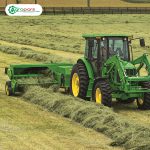Introduction
The square baler is one of the widely used machines in modern agriculture, designed for collecting, compressing, and packaging forage, straw, and other agricultural residues into uniform cubic bales. Utilizing mechanical and hydraulic mechanisms, this device automates the packaging process efficiently and plays a crucial role in enhancing farm productivity. In this article, we will explore the operational mechanism of the square baler, its main components, and the stages of its functionality.

Main Components of the Square Baler
Pick-up Unit
The square baler is equipped with a pick-up unit located at the front of the machine. This component is responsible for collecting scattered forage or straw from the ground. The pick-up unit uses metal or plastic tines to lift materials from the surface and direct them into the machine. The height of this unit can be adjusted based on field conditions and the type of crop.
Compression Chamber
The compression chamber is considered the heart of the square baler. In this section, the collected forage is compressed by a piston into regular cubic shapes. The piston operates with a reciprocating motion, pressing the material layer by layer until it reaches the desired size.
Knotting System
After compression, the bales need to be securely tied to maintain their shape. The knotting system uses twine or wire to bind the cubic bales. This system typically includes needles and knotters that operate automatically, ensuring the bales remain intact during transportation and storage.
Ejection System
Once the bales are tied, they are expelled from the machine through the ejection system. This system often consists of a ramp or a throwing mechanism that releases the bales onto the ground or directly into a wagon attached to the machine.
Stages of Square Baler Operation
Stage 1: Collecting Forage
In the first stage, the square baler, typically attached to a tractor, moves through the field. The pick-up unit gathers scattered materials like straw or alfalfa from the ground and feeds them into the machine. This stage requires precision to prevent stones or unwanted objects from entering the device.
Stage 2: Transfer to the Compression Chamber
After collection, the forage is transferred to the compression chamber. Here, a piston, powered by hydraulic or mechanical force, compresses the material. This process occurs gradually, with each new layer being added to the previous ones until the bale reaches the specified size.
Stage 3: Packaging and Knotting
Once the bale reaches the desired size, the knotting system is activated. The machine’s needles wrap twine or wire around the bale, and the knotters secure it tightly. This stage is critical because improperly tied knots could lead to the bales opening up in subsequent stages.
Stage 4: Ejecting the Bales
Finally, the completed bales are expelled from the machine through the ejection system. The bales are either placed directly on the ground or transferred to a wagon attached to the baler, ready for storage or transportation.
Key Considerations in Operating a Square Baler
Machine Settings
For optimal performance, the machine settings must be adjusted based on the type of crop and field conditions. For instance, the bale density, bale length, and even the height of the pick-up unit should be configured according to specific needs.
Maintenance and Service
Due to operating in harsh field conditions, the square baler requires regular maintenance. Checking the knotting system, lubricating moving parts, and cleaning the pick-up unit are among the tasks that can extend the machine’s lifespan.

Conclusion
With its precise and efficient mechanism, the square baler is an essential tool in modern agriculture. By collecting, compressing, and packaging forage into uniform cubic bales, this machine not only simplifies farmers’ tasks but also contributes to increased productivity and reduced waste. Understanding its operational mechanism and paying attention to its maintenance can ensure long-term, effective performance in the field. If you plan to use a square baler, focusing on proper settings and regular servicing is key to success





